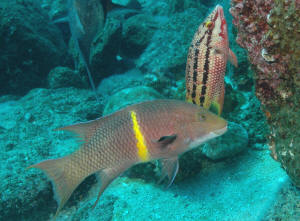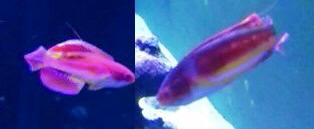|
FAQs on Hogfish Wrasses, Genera Bodianus,
Lachnolaimus Behavior
Related Articles: Hogfish Wrasses,
Lachnolaimus maximus,
Related FAQs: Hogfish 1, Hogfish
2, Lachnolaimus maximus, Hogfish Identification, Hogfish Compatibility, Hogfish Selection, Hogfish Systems, Hogfish Feeding, Hogfish Disease, Hogfish Reproduction, Wrasses, Wrasse Selection, Wrasse Behavior, Wrasse Compatibility, Wrasse Feeding, Wrasse Diseases,
|

Bodianus
diplotaenia (Gill 1862), the Mexican or Cortez Hogfish is
more and more available. A real hardy species; but be forewarned,
it is a real pig, getting big fast (to
two and a half feet in length) from eating most all the food you
can provide. Eastern Pacific. A
male and female in the Galapagos.
|
Candy hogfish behavior
7/11/14
Hi,
<Frank>
I own a yellow candy hogfish and noticed that he has a tendency to nip
Ich off of his fellow tankmates.
<Natural behavior for young Bodianus; but not Ich, the parasites
themselves, but the irritation areas, dead tissue>
I know I should QT my fish and coral, but I'm lazy and impatient. When
it comes to a stress free environment, I believe that Ich should not be
a concern because a healthy fish will not be bothered by it.
<Good>
Anyway, I noticed that when I had a tang that was bullying my borbonius
Anthias there was a outbreak in my tank. Its safe to say I sold my tang
to another reefer and the harmonious balance in the tank is good.
Finally, after the details is all said and done..... I noticed that my
hogfish had no sign of the Ich cysts (he did flash a little). The
hogfish was actually scanning all the fish and nipping the cysts on the
fish and my fish were acting like they were getting cleaned by a shrimp
(staying still and letting him look). These actions lead to my simple
question for this species....do they act as a parasite eater in the wild
<Of a certainty yes. Just read my writing, see my pix on WWM re>
or do you think this is an isolated case. I see that he does this often
and the fish in the tank let him. Thank you again for your help and
wisdom.
Frank
<Cheers, Bob Fenner>
|
Dark Patches on Fishes... expensive Labrid improvements
12/10/13
Dear WWM Crew,
I was lucky enough to be one of the first in my country to own a
Paracheilinus attenuatus. But sadly it turned from a vibrant
coloured specimen to a relatively dull fish with dark patches all over
the top within a couple of weeks. I have attached a picture of the
before and after of the Attenuatus (Pls pardon the poor quality). I
could still see the vibrant colours occasionally when it flashes but it
looks dull otherwise.
My question is, is anything I could do to bring back the colour
of the Attenuatus?
<Likely so... the issue/s here could be simply a lack of space
(needs a bunch relative to its size... see WWM re the genus), or a lack
of females... this and some other genera of Labrids need to live in a
haremic condition to act, look their best>
On a separate note, I got a Bodianus opercularis from a
friend who previously kept three Bodianus Opercularis in a 3 footer
tank.
<... best kept just singly in such a small volume>
The piece that I got from him, being the smallest of the three, was
being dominated, was hiding most of the time and its red parts had
turned very dark red for most part of it's body except the area near the
mouth. The other two pieces looked striking red. I adopted this piece
from my friend in the hope that it will return to its formal striking
red colour once away from the other two Bodianus Opercularis. But it has
been 5 months since I got it but it only recovered slightly, even though
it is doing very well in a 2 ft tank on it's own. My question is..again,
is anything I could do to bring back the colour of the Opercularis?
<Nutrition and water quality would be my twin goals>
Thank you very much and looking forward to your reply. :)
Cheers,
Thomas
<And you; Bob Fenner>
|
 |
|
Hey Bob
2/15/11
<Hey JS!>
I have been reading about the Spanish hogfish on
WWM and other sites now for about two weeks. Coincidentally they
just received one at my local fish store and its vibrant and
beautiful.
<Neat animals. Smart, attractive, interesting
behaviorally>
I just noticed today about the mute-colored 16" specimen in
the picture you have underneath the genus.
Is this what all Spanish hogs look like at an older age and
larger size?
<Usually, yes>
I read some literature that the purple fades,
did you ever notice this through your experience with this
fish?
<Yes>
I want to purchase this fish tomorrow before its sells but if the
purple gets dull and drab, then I will just go with the Cuban
hogfish. Thanks for sharing.
<Oh, this fading will/would take several years. Cheers,
BobF>
Jason
Re: re: Hey Bob
Ohhhh bummer....so all of the yellow goes away? What color does
the purple fade to?
<More pinkish... as in adding white to a tint. B>
Re: re: Hey Bob
Oh ok, that's not bad then.....still colorful. So in several
years and at a larger size the yellow on the fish totally goes
away? I thought it stayed yellow throughout its life.
<... all fades, but not totally>
Re: re: Hey Bob... What? - 2/16/11
Oh ok thanks for getting back to me. Dang....what would I do
without you and this site! Hahaha! Well Bob, I bought him....here
is a pic attached.
Do you see how his purple and yellow are kind of blending?
<... normal>
Will those markings (two-tone yellow/purple) stay the same with
age, or will they change?
<All is change>
I know you said the intensity of the color fades but what about
the distinct separation between the yellow/purple?
<Varies>
I saw the one that was completely purple (a muddy/ugly purple) on
WWM and I am not fond of it.
When they are this "muddy" purple color with no yellow,
are they normally born like that or do they develop this bland
coloring?
<Ditto>
You state that there are different color variations and I guess
I'm just wondering if they keep the two tone yellow/purple
throughout their lives. I don't mind the "fading"
and decrease in color intensity but I would hope they keep the
two-tone markings.
Thanks again!
<Welcome. B>
|
|

|
|
Re: re: Hey Bob... Bodianus
colour/beh. 2/17/11
Oh boy, I really hate to be annoying and a pain in the butt
...but I am confused about one of your replies in the last email.
The verbiage in between your reply "varies" and
"ditto", I don't understand what your reply
"ditto" is referring to. Since I typed a two-part
question which part of the question does your reply refer to:
"born with this muddy coloration" or "develop at
an older age"? I mean, do ALL Spanish hogs turn into
full-bodied brownish/pinkish/purple coloring without the yellow
(yellow going away completely)?
When purchasing this fish, I was under the assumption that if it
had yellow as young, it will always have yellow. Granted, it may
fade intensity and may blend a good amount but yellow will always
be visible.
<Sorry for the lack of clarity... the fish will remain yellow
and purplish throughout its life, just less so with time. Clear?
B>
Re: re: Hey Bob
Hey, no apologies Bob ....it was probably just me having a
"dense" moment.
Thanks again, enjoy the rest of your week!
<Ahh, thank you>
Re: re: Thalassoma and Coris <not>
compatibility 3/28/11
Hey Bob, what are the chances that my Spanish
hog will take on the "muddy" morph as it
grows?
<... not likely>
I think its real ugly and its a waste of space in my 90. Most I
see are proportionately purple/yellow. But when I Google (and in
your book) I see a brown/purple overall blended together....not
so attractive.
<This/that is an unusual "color morph">
My 4" is well proportioned color wise...at this size would I
already see the "muddy" morph if it was going to be
that way in the end at larger size?
<Thought I'd/we'd already gone over this.>
|
Lachnolaimus maximus growth - 12/6/07 Hi Robert
<Sorry, Lynn here this morning!> I read that Lachnolaimus maximus
are slow growers, but how slow is slow? <Actually, they can grow
fairly quickly.> How long does it take to attain 15 inches?
<Depends on how well fed they are. Please see this link (and related
links above) for more info re:
http://www.wetwebmedia.com/lachnolaimus.htm > Thanks <You're
very welcome. -Lynn>
Cuban Hogfish behavior Hello I have had a 120 saltwater fish
only tank going for about a year now. I have a lionfish,
Foxface and a Cuban hogfish. I just recently purchased the
hog a couple of days ago from my LFS. He Lays on the sand in
the corner but when someone goes into that room he comes up swims
around and acts normal. I have been feeding him a variety
frozen prepared twice a day. Is laying down on the sand for
a while normal for a Cuban hogfish? Do you think I should be feeding
him more often? <Likely normal, you can read about how they are when
introduced on WetWebMedia.com (look up Cuban Hogfish). As
long as he recognizes you and reacts when you come in the room he is
likely alright. I wouldn't feed any more often than you
are. Craig>
|
|

